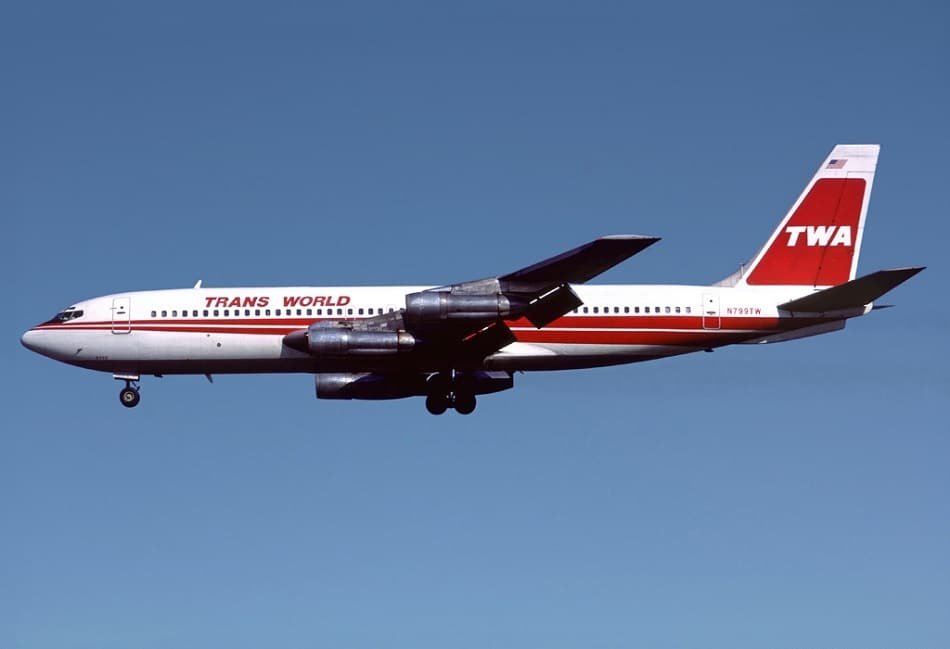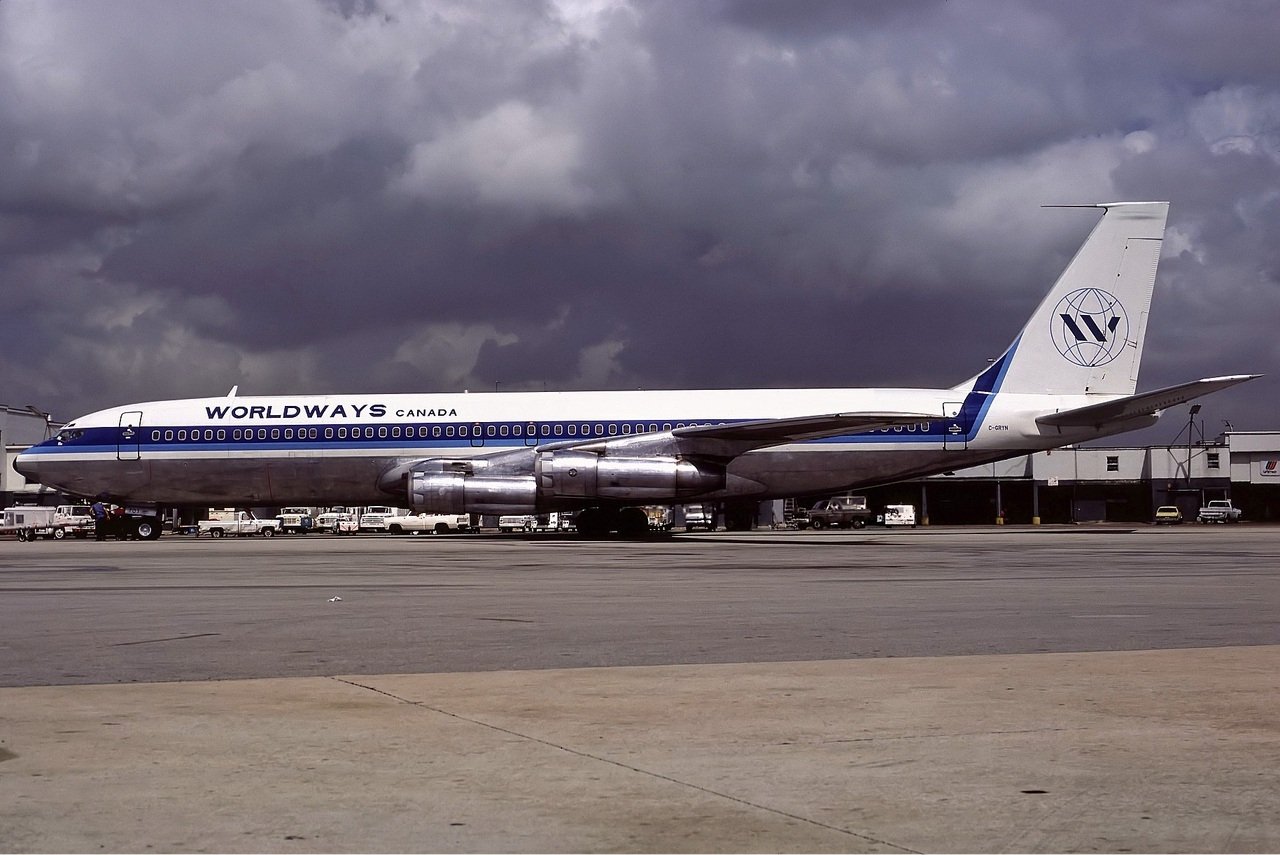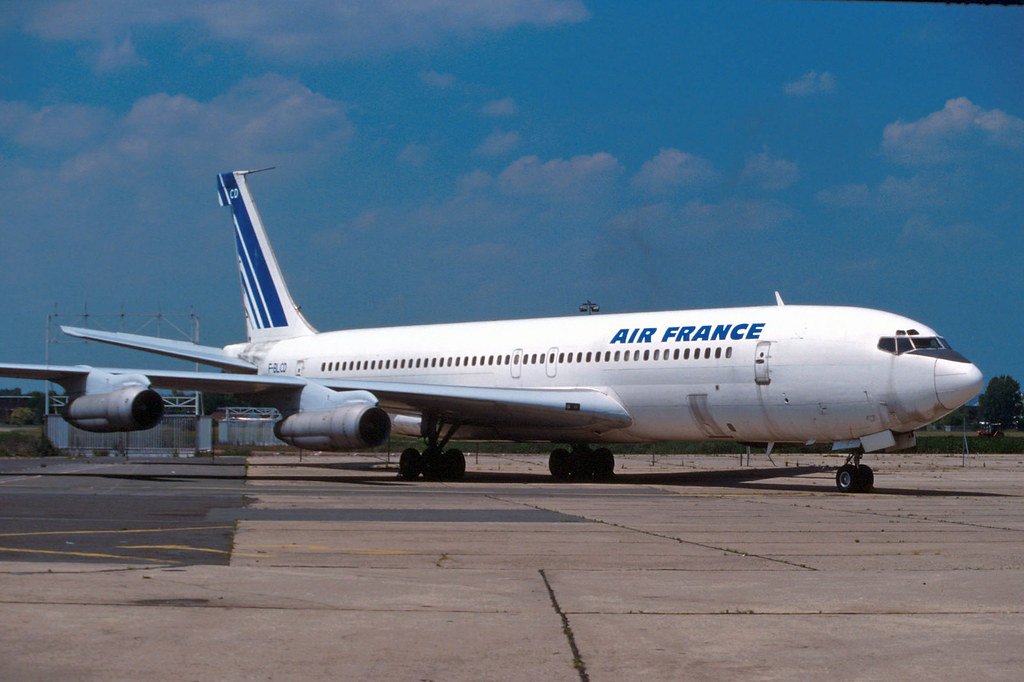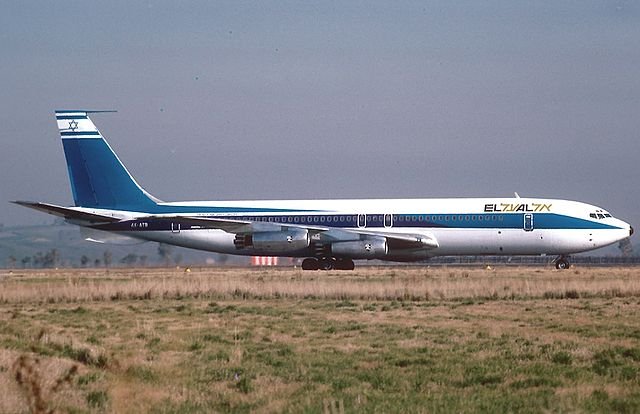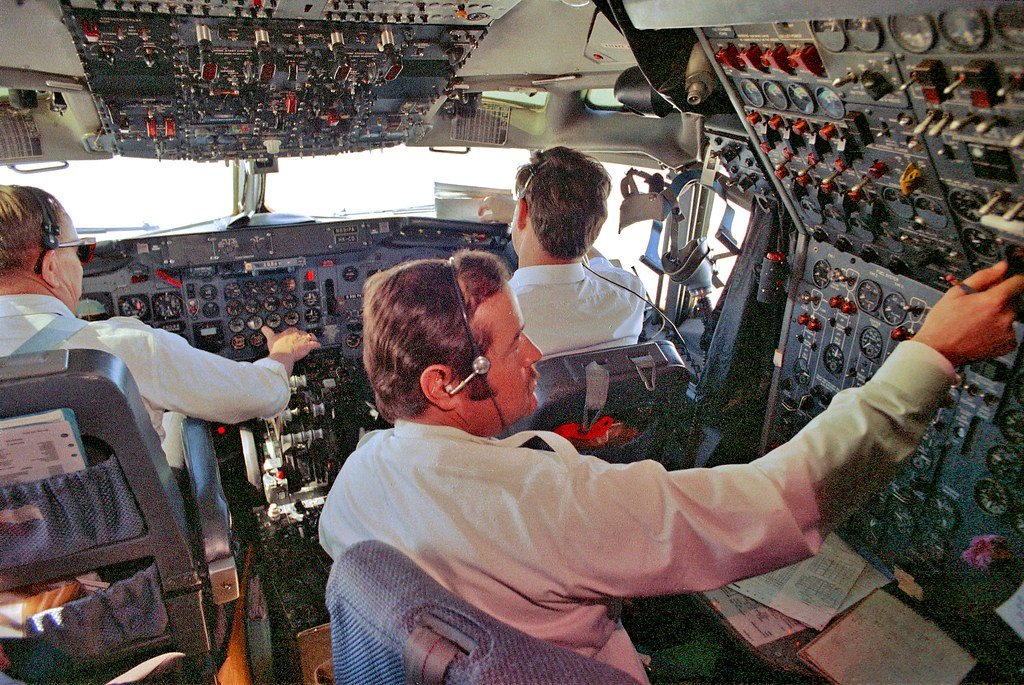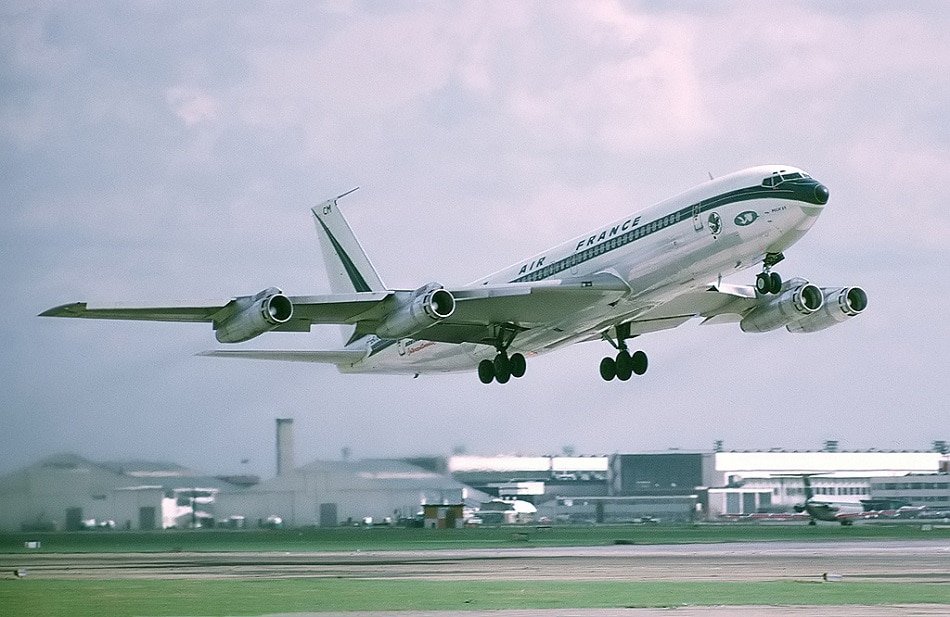
Boeing 707
SPECS
HISTORY
ORDERS
Boeing-707-131B-Trans-World-Airlines-TWA Reg N799TW.
When we think of passenger aviation history, our minds automatically go back to the beginnings of the Boeing 747, the Queen of Skies, that changed travel for the general public forever. The predecessor of the Boeing 747, however, was every bit as exciting and influential on how we travel today.
If we go back to the late 1940s and early 1950s, the passenger-carrying airliners of the time were propeller-driven aircraft, which by today's standards were slow, small, and unable to fly above the weather as we do today. The British were actually the first in the air with a passenger jetliner in the form of the de Havilland Comet, first flying on 27 July 1949.
Due to several design faults, the Comet was not very successful. It did, however, offer valuable lessons that would be used by other manufacturers of jet airliners in the future. The Comet would also not have been able to compete with the upcoming jet airliners as it was smaller and slower.
| Boeing 707 | 707-120B | 707-320/-420 | 707-320B | 707-320C |
|---|---|---|---|---|
| Crew | 3 Pilot, Copilot, Flight Engineer. | |||
| First Flight | 20 December 1957 | 11 January 1958 | 11 January 1959 | - |
| Number Produced | 300 | 106 | 174 | 337 |
| Passengers 1 Class | 174 | 189 | 189 | 195 |
| Passengers 2 Class | 137 | 141 | 141 | 141 |
| Fuselage Width | 3.759m (12ft 4in) | |||
| Aircraft Length | 44.22m (145ft 1in) | 46.61m (152ft 11in) | ||
| Tail Height | 12.70m (41ft 8in) | 12.85m (42ft 2in) | 12.83m (42ft 1in) | 12.80m (42ft 0in) |
| Main Wing Span | 39.88m (130ft 10in) | 43.41m (142ft 5in) | 44.42m (145ft 9in) | |
| Main Wing Area | 226.3m2 (2,433ft2) | 283m2 (3,050ft2) | ||
| Operating Empty Weight | 57,600kg (127,500lb) | 64,600kg (142,600lb) | 67,500kg (148,800lb) | 67,300kg (148,300lb) |
| MTOW | 117,000kg (257,340lb) | 141,700kg (312,000lb) | 151,500kg (333,600lb) | |
| Takeoff Distance | 2,300m (7,500ft) | 3,250m (10,700ft) | 3,000m (10,000ft) | |
| Landing Distance | 2,000m (6,500ft) | 2,200m (7,200ft) | 1,800m (5,900ft) | 1,900m (6,200ft) |
| Fuel Capacity | 65,601L (14,430imp gal; 17,330US gal) | 90,169L (19,834imp gal; 23,820US gal) | 90,301L (19,863imp gal; 23,855US gal) | |
| Engines x 4 | Pratt & Whitney JT3D-3 | -320 Pratt & Whitney JT4A-11/12 -420 Rolls Royce Conway-12 |
Pratt & Whitney JT3D | |
| Engine Thrust x 4 | 80kN (18,000lbf) | 78kN (17,500lbf) | 85kN (19,000lbf) | |
| Speed (Max Cruise) | 484-540kn / 897-1000kph | 478-525kn / 885-974kph | ||
| Service Ceiling | 42,000feet (12,800 metres) | |||
| Range | 9,300km / 5,000nm | 5,400km / 2,900nm | 9,300km / 5,000nm | 5,400km / 2,900nm |
| Boeing 707 | 707-120B | 707-320/-420 | 707-320B | 707-320C |
SPECIFICATIONS
During and following World War II, the Douglas Aircraft Company led in the area of passenger transport, whereas Boeing at this time was more known for its military aircraft. These included models such as the B-17 Flying Fortress, B-29 Super Fortress, B-47 Stratojet, and of course the B-52 Stratofortress.
Boeings only passenger airliners were the Boeing 314 Clipper flying boat, the Boeing 377 Stratorcruiser, and the Boeing 307 Stratoliner.
During 1949/1950, Boeing started looking at new designs for a jet that would appeal to the civilian market as well as the military market. For the military, air-to-air refueling was becoming a common practice and a solution had to be found for jet bombers, one that could keep pace with these faster aircraft.
History.
A Boeing 707-138B QANTAS N707JT. This is the aircraft owned by actor John Travolta and named Jet Clipper Johnny LLC. Travolta has donated the aircraft to the HARS Aircraft Museum in Shellharbour south of Sydney, Australia. At the time of writing at the beginning of 2023, the logistics of getting the aircraft from the US to Australia have yet to be overcome.
It may seem hard for us to believe today, but the success of a new jet airliner was not assured. Boeing looked at many designs around wings and engine layouts before they went ahead and built a prototype. The 367-80, known as the Dash 80, rolled out of the factory on 14 May 1954 and first flew on 15 July 1954, within 2 years of the project launch. This was the only model of its type built and today can be viewed at the National Air and Space Museum's Steven F. Udvar-Hazy Center in Washington, DC. This was a proof-of-concept aircraft with the US military becoming the first customer who saw this as the basis for their KC-135 Stratotanker.
Having the military as a customer at least gave Boeing an each-way bet.
The only Boeing 367-80 built, registration N70700. Seen here at the National Air and Space Museum's Steven F. Udvar-Hazy Center in Washington, DC.
The 367-80 prototype still leaned on the configuration of the Stratoliner and Stratorcruiser with a seating configuration of four seats across, two on either side of the aisle in a fuselage that was 3.35 metres (11 feet) wide. The market pressured Boeing to widen the fuselage to which Boeing responded by coming back with a configuration of five seats across in a fuselage 3.66 metres (12 feet) wide.
By this stage, Douglas had their DC-8 on the drawing board and it boasted six seats across. Boeing once again responded by coming back a final time with the six seats across configuration at a fuselage width of 3.76 metres (12 feet 4 inches). The airlines were much happier with the extra space this gave them.
Experience and feedback obtained by the 367-80 were brought into the final design phase of the B707. In fact, as we mentioned earlier, lessons learned from the de Havilland Comet were also taken into account. One such was the addition of a Krueger Flap on the leading edge of each wing between the inboard and outboard engines. The Comet had some runway overrun instances on take-off as the wing would stall if the aircraft was over-rotated on take-off. The Krueger Flaps ensured this would not happen, even if the tail of the aircraft was dragged along the runway.
Worldways Canada Boeing 707-338C.
The first standard model of the Boeing 707 was the 707-120, using Pratt and Whitney JT3C turbojet engines. The 707-120 first flew on 20 December 1957, with F.A.A. certification following less than a year later on 18 September 1958.
As with any airliner, the first variant is rarely the only one, nor is it necessarily the most popular. The 120 series sold successfully, but the later 320 series would turn out the be the most popular seller.
Even within a series, modifications were made at the request of customers. For instance, Australian national flag carrier, QANTAS (Queensland And Northern Territory Air Services) ordered a shortened version, by 3.04 metres (10 feet), of the Boeing 707-120. Given the classification of 707-138, this variant was for all intents and purposes a shorter and therefore lighter version of the 707-120, with the same maximum take-off weight (MTOW). This allowed QANTAS to use their 707 on longer flight sectors as dictated by their remote location.
Boeing 707-138 QANTAS Reg VH-XBA. This was shortened model requested by QANTAS to allow the same Maximum Takeoff Weight (MTOW) as the standard version which allowed more fuel to be carried for longer-range flights.
Braniff International Airways ordered a higher-powered 707-220 which used the Pratt and Whitney JT4A engines. Only 5 of these were produced. The most popular 707 variant was the 707-320. This model sported an extended wingspan and the more powerful JT4A engines. One other model was added to the stable, the 707-420 which was essentially a 320 which carried Rolls Royce Conway engines.
The 707's British certification depended on the aircraft being able to execute a go-round with one engine out. It was determined that to achieve this, the height of the tail fin had to be increased as well as the addition of a ventral fin below the tail. Boeing carried out these modifications. The increase in the tail height and the addition of the ventral fin also served to control the Dutch Roll which is a feature of aircraft with swept-back wings.
The Dutch Roll is a behaviour that involves the simultaneous yawing and rolling of the aircraft. Yawing occurs when an aircraft is straight and level and the nose and tail swing from side to side. Rolling is when the aircraft is flying level but its wings dip up and down. Combine these two behaviours and you have a very uncomfortable ride. More than uncomfortable, as demonstrated on a brand-new aircraft to be delivered to Braniff International Airways. On a training flight, the pilots were shown the effects by turning off the yaw dampers. A less-than-gentle input by one of the pilots resulted in three of the engines being ripped off and the aircraft crash-landing. Four of the eight occupants were killed.
Boeing 707-323C of American Airlines registration N7555A at Basle April 1976.
The initial engines on the Boeing 707 were turbojets, and the Pratt and Whitney JT3C. However, it was the Pratt and Whitney JT3D turbofan variant of the JT3C that became the most popular 707 engine. The JT3D turbofan was a more powerful and fuel-efficient engine. Many of the original 707s powered by the JT3C were converted to this enhanced power plant. 707s powered by the JT3D had a B appended to their model designation, such as 707-120B.
The 707-320 only came out with the JT3D engine option. This variant had a stronger structure and other modifications to make it truly intercontinental and depended on this newer engine for its performance.
The long-haul routes we take for granted today were starting to be made possible by the 707 and DC8. The 707-320B was now capable of flying westbound from Europe to the US West Coast and the US to Japan.
This is a personal picture taken at Dubai Airport in June 1973. Here my family was travelling from Kuala Lumpur, Malaysia to London Heathrow with the obligatory refueling stop in Dubai. The aircraft, owned by B.O.A.C. (British Overseas Airline Corporation) a forerunner of British Airways, was a Boeing 707-436. The 43X designation was, as shown in the table below, due to it being equipped with Rolls Royce Conway engines. To comply with British certification conditions, this model sported the larger tail fin as well as the ventral fin below the tail which is nicely shown off here.
The final variant of the Boeing 707 was the 707-320C. The C stood for convertible as this aircraft could alternate between being a passenger-carrying aircraft and a cargo carrier. It came with a large fuselage cargo door, three leading-edge sectional flaps, and improved landing and take-off performance. The ventral tail fin was also removed.
These improvements to the wing were incorporated into 707-320B aircraft from 1963 onwards. These 707-320Bs were known as the 707 Advanced.
Boeing did commence a test program for a 707-700 which used CFM International CFM56 engines. The program was abandoned as it was felt that such a model would detract from the Boeing 767 and Boeing 757 programs.
Pan Am Boeing 707 landing in Miami 1971. Registration N459A.
So who was the launch customer for the Boeing 707? Back during this time Juan Trippe and the guys down at Pan Am (Pan American World Airways) were a force to be reckoned with, true visionaries of their time.
As with the Boeing 747 in later years, Pan Am could see the market potential of the new jet airliners and backed themselves by ordering twenty Boeing 707s and 25 Douglas DC8s. This resulted in them being able to boast for a year that they were the only operator of American intercontinental jet transports. Pan Am's first orders for the Boeing 707 were placed on 13 October 1955.
On 17 October 1958, Pan Am's first 707 was christened at National Airport, Washington, DC. The event was attended by President and First Lady Eisenhower, Pan Am founder Juan Trippe and other VIPs. First Lady Eisenhower christened the aircraft, registration N710PA, as Jet Clipper America. Thereafter guests of Juan Trippe joined an inaugural service from Baltimore's Friendship International Airport to Paris.
Lineas Aereas Paraguayas Boeing 707-300.
Boeing 707-123B (1959) Cockpit. The computer-driven glass cockpit screens of today are still years away when the Boeing 707 came on the scene. Here we can see the pilot and copilot seats with their control yokes. To the bottom right we have the flight engineer's seat and station where all systems were monitored. His seat could also rotate to a front-facing position where he would assist the pilot-in-command with engine controls in the take-off and landing phases of flight. The seat on the bottom left was known as the jump seat and could be occupied by a spare pilot on long flights.
The first commercial service of the Boeing 707 was on 26 October 1958 and departed New York's Idlewild Airport, with a stopover for refueling at Gander, Newfoundland, its final destination was Paris, Le Bourget Airport. So, air travel had now changed forever.
Boeing had opted for pressing ahead with the 707 and using the lower-powered JT3C engines. As we have seen they later upgraded these to the JT3D. Douglas, on the other hand, waited for the newer engines to become available and thus avoided any upgrading or retrofitting of newer engines.
This might have been prudent as far as rework was concerned, however, they may well have lost market share as their DC-8 was later to market than the 707. Airlines such as United, Delta, and Eastern had to wait for their DC-8 aircraft and thereby also lost market share due to their lack of jet aircraft.
American Airlines were the first to fly domestic services using their own 707s. They were soon followed by TWA (Trans World Airlines) and Continental Airlines. In 1959 QANTAS became the first international airline to receive its 707s.
The Boeing 707 became the most popular airliner of the day. It forced changes in the way people travelled as a whole. Changes were made to airport terminals, runways, airline catering, baggage handling, reservations systems, and air traffic control. She appeared in songs such as Steve Miller Band's, "Jet Airliner". "As I get on the 707".....
The 707 represented cutting edge of aviation technology and became the symbol of air travel in general. Arthur Halley's original "Airport" book and the subsequent movie featured the 707.
Air travel had never been so popular. More people were flying than ever before and there came the problem. The 707 could not be enlarged any further. More powerful engines would require more ground clearance which would require new landing gear which would take a whole redesign.
In short, a whole new design would be called for.
The 707 became a victim of its own popularity. This wasn't the sole issue. Engine technology was moving on due to increasing fuel prices, which were drastically highlighted during the 1973 oil crisis. In addition, aircraft noise was becoming a hot topic and tighter restrictions around this started to threaten the very existence of older jet engines. In 1985 International Noise regulations threatened the future of the existing 707s. To extend the life of these airliners, Shannon Engineering of Seattle created a hush kit that could be retrofitted to these aircraft. It was known as the Quiet 707 package.
Boeing 707-368C Spanish Air Force.
The production of the passenger-carrying 707 ended in 1978 with 1,010 having rolled out of the factory. The production line actually remained open until 1991 for military versions. These last versions were the E-3 and E-6.
In the US the last scheduled passenger service using the Boeing 707 was flown by TWA on 30 October 1983. Saha Airlines of Iran was the last airline to end services of the 707 in April 2013. By 2019, a small number of 707s were still flying in military roles such as aerial refuelling services or AWACS (Airborne Warning and Control System).
The 707, although it was superseded by the Boeing 747, still lives on in our world of travel. The nose section, fuselage cross-section and cockpit configuration carried forward to the Boeing 727, 757, and of course our still very popular 737. Yes, if you sit in a 737 cabin, look around and appreciate that this is the spacious cabin that 707 travellers got excited about.
Boeing interior which could be Boeing 707, 727 or 737.
A well-known version of the Boeing 707 is the one owned by actor John Travolta. This aircraft, registration N707JT, has been meticulously restored in QANTAS V-Jet livery.
Why V-Jet? one might ask.
V-Jet was a marketing name used by QANTAS with the V standing for the Latin word, vannus. Vannus which loosely translates to fan in English referred to the turbo-fan engines that the 707-320B was equipped with.
The John Travolta 707 is to be donated to the H.A.R.S. (Historical Aircraft Restoration Society) Aircraft museum at Shellharbour Regional Airport (YSHL) just south of Sydney, Australia. The arrival was slated for November 2019 but due to Covid and also factors around where the aircraft would refuel across the Pacific during the transfer is, shall we say, still up in the air.
If, like me to were lucky enough to have travelled on a 707 or have any 707 anecdotes, please feel free to share those below in the comments. We would love to hear your stories.
Orders and Deliveries.
| Airlines | Ordered | Delivered |
|---|---|---|
| Aer Lingus | 7 | 7 |
| Aerolineas Argentinas | 6 | 6 |
| Air France | 38 | 38 |
| Air India | 11 | 11 |
| Airlift International | 3 | 3 |
| Airline of the Islamic Republi | 3 | 3 |
| American Airlines | 128 | 128 |
| Avianca | 5 | 5 |
| Aviation Service & Support | 2 | 2 |
| Braniff Airlines | 19 | 19 |
| British Airways | 29 | 29 |
| British Caledonian Airways | 2 | 2 |
| British Eagle International | 2 | 2 |
| British Royal Air Force | 7 | 7 |
| CAAC-Civil Aviation of China | 10 | 10 |
| Cameroon Airlines | 1 | 1 |
| Canadian Air Force | 5 | 5 |
| China Airlines | 2 | 2 |
| Eastern Air Lines | 15 | 15 |
| EgyptAir | 9 | 9 |
| EL AL Israel Airlines | 10 | 10 |
| Estado Nacional Argentino ENA | 1 | 1 |
| Ethiopian Airlines Group | 5 | 5 |
| Executive Jet Aviation | 2 | 2 |
| FAA | 1 | 1 |
| Flying Tiger | 4 | 4 |
| German Air Force | 4 | 4 |
| Government of Egypt | 1 | 1 |
| Iraqi Airways | 5 | 3 |
| Islamic Republic of Iran Air F | 15 | 15 |
| Kingdom of Saudi Arabia | 14 | 14 |
| Korean Air | 1 | 1 |
| Kuwait Airways | 5 | 5 |
| LATAM Airlines Group | 1 | 1 |
| Libyan Airlines | 1 | 1 |
| Lufthansa | 31 | 31 |
| Middle East Airlines | 4 | 4 |
| MSA-Malaysia/Singapore A/L | 3 | 3 |
| NATO | 18 | 18 |
| Nigeria Airways | 3 | 3 |
| Northwest-Merged w Delta | 49 | 49 |
| Olympic Airlines | 6 | 6 |
| Pacific Northern | 2 | 2 |
| Pakistan International Airline | 11 | 11 |
| Pan Am World Airways | 129 | 126 |
| Pelita Air Service | 1 | 1 |
| Qantas Airways | 34 | 34 |
| Qatar Airways | 1 | 1 |
| Republic of France | 4 | 4 |
| Republic of Portugal | 2 | 2 |
| Royal Jordanian | 2 | 2 |
| Royal Moroccan Air Force | 1 | 1 |
| SABENA Aerospace | 14 | 14 |
| Saudi Arabian Airlines | 9 | 9 |
| Seaboard World Airlines | 2 | 2 |
| Socialist Republic of Romania | 2 | 2 |
| South African Airways | 10 | 10 |
| Sudan Airways | 2 | 2 |
| TAP Portugal | 7 | 7 |
| TAROM Romanian Air Transport | 2 | 2 |
| TWA | 127 | 127 |
| U.S. Air Force | 40 | 39 |
| United Airlines | 55 | 55 |
| United States Navy | 17 | 17 |
| Varig Airlines | 9 | 9 |
| Wardair | 2 | 2 |
| Western Airlines | 34 | 34 |
| World Airways, Inc. | 9 | 9 |
| Grand Total | 1016 | 1010 |
A Turkish Airlines Boeing 707 landing at Zurich April 1976.
Continental Airlines- Golden Jet Boeing 707.
Boeing B-707-320 Air France.
Boeing 707-458 El Al Israel Airlines.
A Pan Am Pilot and Cockpit Crew on Board a Boeing 707. With the introduction of the Boeing 757 and 767 the three cockpit was done away with. The flight engineer panel, on the right, was integrated into the panels of the pilot and co-pilot and two man flight crews have been the norm ever since.




